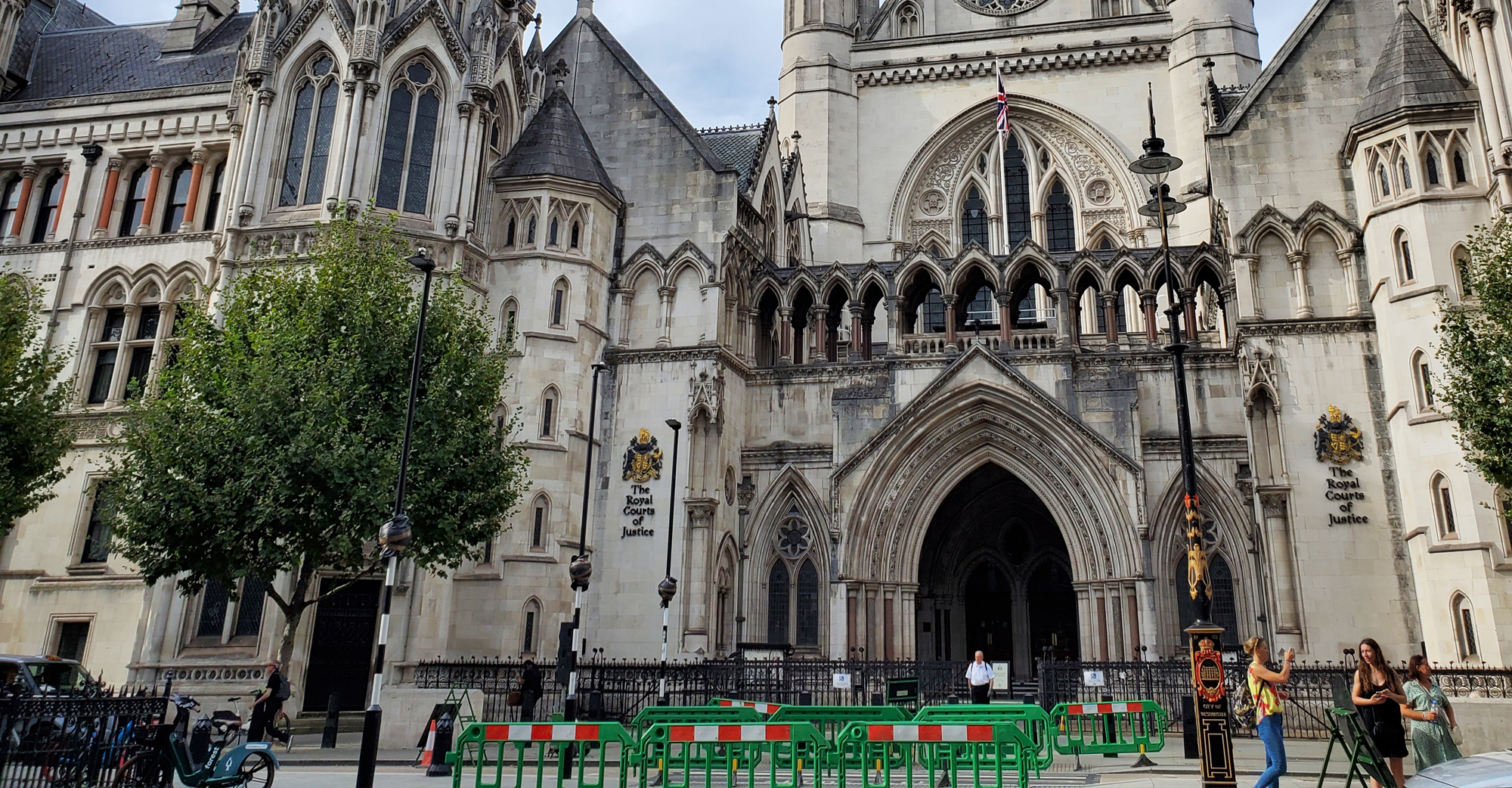Curated by Ed Boitano
Name the movie NOT based on the writings of F. Scott Fitzgerald. How many Hitchcock films starred Cary Grant? How about James Stewart? These questions and more are addressed in Traveling Boy’s 46th installment of American Cinema Trivia Games. No one will see your answers except for you.
Global Trivia 46
Start
Congratulations!
You have completed Global Trivia 46.

You scored %%SCORE%% out of a possible 5 points.
Your performance was: %%RATING%%
Your answers are highlighted below.
Question 1 |
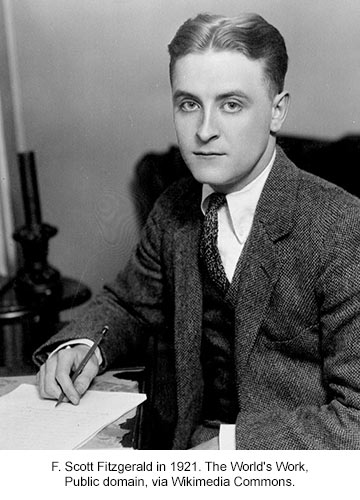
Name the movie NOT adapted from the writings of F. Scott Fitzgerald.
A | The Curious Case of Benjamin Button |
B | The Great Gatsby |
C | The Last Tycoon |
D | The Sun Also Rises |
E | Tender Is the Night |
Question 1 :
Answer D. The Sun Also Rises (1957)
Director: Henry King
Writers: Peter Viertel (screenplay), Ernest Hemingway (novel)
Stars: Tyrone Power, Ava Gardner, Errol Flynn
A group of disillusioned American expatriate writers live a dissolute, hedonistic lifestyle in 1920s France and Spain.
The Curious Case of Benjamin Button (2008)
Director: David Fincher
Writers: Eric Roth (screenplay), F. Scott Fitzgerald
Stars: Brad Pitt, Cate Blanchett, Tilda Swinton, Julia Ormond
Scott Fitzgerald's short story of Benjamin Button, a man who starts aging backwards.
The Great Gatsby (1926)
Director: Herbert Brenon
Writers: F. Scott Fitzgerald (novel), Elizabeth Meehan (adaptation)
Stars: Warner Baxter, Lois Wilson, Neil Hamilton, Georgia Hale
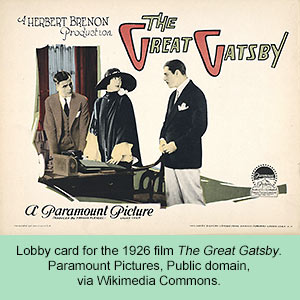
The Great Gatsby (1949)
Director: Elliott Nugent
Writers: F. Scott Fitzgerald (novel), Owen Davis (play) | 2 more credits »
Stars: Alan Ladd, Betty Field, Macdonald Carey, Shelley Winters
The Great Gatsby (1974)
Director: Jack Clayton
Writers: F. Scott Fitzgerald (novel), Francis Ford Coppola (screenplay)
Stars: Robert Redford, Mia Farrow, Bruce Dern, Sam Waterston, Karen Black, Scott Wilson
The Great Gatsby (2013)
Director: Baz Luhrmann
Writers: Baz Luhrmann (screenplay), Craig Pearce (screenplay) | 1 more credit »
Stars: Leonardo DiCaprio, Carey Mulligan, Joel Edgerton
Nick Carraway, a young Midwesterner now living on Long Island, finds himself fascinated by the mysterious past and lavish lifestyle of his neighbor, the nouveau riche Jay Gatsby. He is drawn into Gatsby's circle, becoming a witness to obsession and tragedy.
Post Script: 'The Great Gatsby: Copyright Expiration of the Novel Leads to Prequel.
Between the glitzy parties, secret backstories and climactic murder in F. Scott Fitzgerald’s classic novel The Great Gatsby, there’s a tiny detail that readers may have missed: right before he gets in a car with antagonist Tom Buchanan — the ride that kicks off the novel’s tragic end — narrator Nick Carraway realizes he’s forgotten his own birthday. It’s a detail that stuck with author Michael Farris Smith when he re-read the novel in his 40s, and sparked a lingering question: What makes a man so detached from himself that he doesn’t remember his own birthday?
In Nick, Smith’s prequel to The Great Gatsby, out Jan. 5, the author explores Carraway’s life before he arrives in Jay Gatsby’s world in West Egg, ruminating on his travels and search for home during and after serving in World War I. The timing of the prequel may seem strange, arriving 96 years after the original book’s publication, but it’s intentional: Smith’s novel will be published just days after Gatsby enters U.S. public domain on Jan. 1. Literary works are protected from replication for a certain number of years, depending on when they came out. When the copyright for Fitzgerald’s classic novel of greed, desire and betrayal expires, anyone will be able to publish the book and adapt it without permission from his literary estate, which has controlled the text for the 80 years since his death. That freedom could yield works that add to Gatsby’s legacy — see what Wide Sargasso Sea did for Jane Eyre — or it could open the door to editions that change the text for the worse.
The Last Tycoon (1976)
Director: Elia Kazan
Writers: F. Scott Fitzgerald (novel), Harold Pinter (screenplay)
Stars: Robert De Niro, Tony Curtis, Robert Mitchum, Jack Nicholson, Jeanne Moreau, Ingrid Boulting, Theresa Russell
Scott Fitzgerald's unfinished and posthumous novel is brought to life in this story of a movie producer slowly working himself to death. It was Kazan’s last film.
Also TV Series (2016–2017) The Last Tycoon
Tender Is the Night (1962)
Director: Henry King
Writers: Ivan Moffat (screenplay), F. Scott Fitzgerald (novel)
Stars: Jennifer Jones, Jason Robards, Joan Fontaine
Based on F. Scott Fitzgerald's novel about the rich on the Riviera in the 1920s. The story centers on a psychiatrist and his relationship with a beautiful patient.
Also: TV Mini-Series (1985)
Director: Henry King
Writers: Peter Viertel (screenplay), Ernest Hemingway (novel)
Stars: Tyrone Power, Ava Gardner, Errol Flynn
A group of disillusioned American expatriate writers live a dissolute, hedonistic lifestyle in 1920s France and Spain.
Movies Adapted From the Writings of F. Scott Fitzgerald
The Curious Case of Benjamin Button (2008)
Director: David Fincher
Writers: Eric Roth (screenplay), F. Scott Fitzgerald
Stars: Brad Pitt, Cate Blanchett, Tilda Swinton, Julia Ormond
Scott Fitzgerald's short story of Benjamin Button, a man who starts aging backwards.
The Great Gatsby (1926)
Director: Herbert Brenon
Writers: F. Scott Fitzgerald (novel), Elizabeth Meehan (adaptation)
Stars: Warner Baxter, Lois Wilson, Neil Hamilton, Georgia Hale

The Great Gatsby (1949)
Director: Elliott Nugent
Writers: F. Scott Fitzgerald (novel), Owen Davis (play) | 2 more credits »
Stars: Alan Ladd, Betty Field, Macdonald Carey, Shelley Winters
The Great Gatsby (1974)
Director: Jack Clayton
Writers: F. Scott Fitzgerald (novel), Francis Ford Coppola (screenplay)
Stars: Robert Redford, Mia Farrow, Bruce Dern, Sam Waterston, Karen Black, Scott Wilson
The Great Gatsby (2013)
Director: Baz Luhrmann
Writers: Baz Luhrmann (screenplay), Craig Pearce (screenplay) | 1 more credit »
Stars: Leonardo DiCaprio, Carey Mulligan, Joel Edgerton
Nick Carraway, a young Midwesterner now living on Long Island, finds himself fascinated by the mysterious past and lavish lifestyle of his neighbor, the nouveau riche Jay Gatsby. He is drawn into Gatsby's circle, becoming a witness to obsession and tragedy.
Post Script: 'The Great Gatsby: Copyright Expiration of the Novel Leads to Prequel.
Between the glitzy parties, secret backstories and climactic murder in F. Scott Fitzgerald’s classic novel The Great Gatsby, there’s a tiny detail that readers may have missed: right before he gets in a car with antagonist Tom Buchanan — the ride that kicks off the novel’s tragic end — narrator Nick Carraway realizes he’s forgotten his own birthday. It’s a detail that stuck with author Michael Farris Smith when he re-read the novel in his 40s, and sparked a lingering question: What makes a man so detached from himself that he doesn’t remember his own birthday?
In Nick, Smith’s prequel to The Great Gatsby, out Jan. 5, the author explores Carraway’s life before he arrives in Jay Gatsby’s world in West Egg, ruminating on his travels and search for home during and after serving in World War I. The timing of the prequel may seem strange, arriving 96 years after the original book’s publication, but it’s intentional: Smith’s novel will be published just days after Gatsby enters U.S. public domain on Jan. 1. Literary works are protected from replication for a certain number of years, depending on when they came out. When the copyright for Fitzgerald’s classic novel of greed, desire and betrayal expires, anyone will be able to publish the book and adapt it without permission from his literary estate, which has controlled the text for the 80 years since his death. That freedom could yield works that add to Gatsby’s legacy — see what Wide Sargasso Sea did for Jane Eyre — or it could open the door to editions that change the text for the worse.
The Last Tycoon (1976)
Director: Elia Kazan
Writers: F. Scott Fitzgerald (novel), Harold Pinter (screenplay)
Stars: Robert De Niro, Tony Curtis, Robert Mitchum, Jack Nicholson, Jeanne Moreau, Ingrid Boulting, Theresa Russell
Scott Fitzgerald's unfinished and posthumous novel is brought to life in this story of a movie producer slowly working himself to death. It was Kazan’s last film.
Also TV Series (2016–2017) The Last Tycoon
Tender Is the Night (1962)
Director: Henry King
Writers: Ivan Moffat (screenplay), F. Scott Fitzgerald (novel)
Stars: Jennifer Jones, Jason Robards, Joan Fontaine
Based on F. Scott Fitzgerald's novel about the rich on the Riviera in the 1920s. The story centers on a psychiatrist and his relationship with a beautiful patient.
Also: TV Mini-Series (1985)
Question 2 |
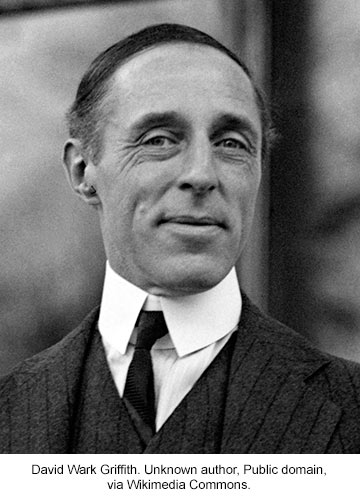
Name the film NOT directed by D.W. Griffith
A | Broken Blossoms |
B | Greed |
C | Orphans of the Storm |
D | True Heart Susie |
E | Way Down East |
Question 2 :
Answer B Greed (1924); Director: Erich von Stroheim
Broken Blossoms (1919)
True Heart Susie (1919)
Way Down East (1920)
Orphans of the Storm (1921)
David Wark Griffith was born in rural Kentucky to Jacob "Roaring Jake" Griffith, a former Confederate Army colonel and Civil War veteran. Young Griffith grew up with his father's romantic war stories and melodramatic nineteenth-century literature that were to eventually shape his movies. In 1897 Griffith set out to pursue a career both acting and writing for the theater, but for the most part was unsuccessful. Reluctantly, he agreed to act in the new motion picture medium for Edwin S. Porter at the Edison Company. Griffith was eventually offered a job at the financially struggling American Mutoscope & Biograph Co, which is still in existence today and the oldest movie company in America, where he directed over four hundred and fifty short films. His experimentation with visual story-telling techniques would later be perfected in his cinematic epic, The Birth of a Nation (1915).
Griffith and his personal cinematographer G.W. Bitzer collaborated to create and perfect such cinematic devices as the shot sequence, the flashback, the iris shot, the mask and cross-cutting – in essence, the very language of film still used today. He has been called "the father of film technique," "the man who invented Hollywood," and "the Shakespeare of the screen."
He produced and directed the first movie ever made in Hollywood, In Old California (1910), and was the first to utter the catchphrase "Lights, camera, action!" The film was rediscovered by Biograph and shown on the 6th of May 2004 at the Beverly Hills Film Festival.
While he was known to have no real sense of humor, he is credited as designing the blueprint for screen slapstick. In 1908 he made a short film about a man who accidentally breaks a curtain pole. The comedy, called The Curtain Pole, starred an actor by the name of Mikhail Sinot, who changed his name to Mack Sennett.
In 1920 he established United Artists with Charles Chaplin, Douglas Fairbanks and Mary Pickford.
Following "Birth," Griffith never again saw the same monumental success as his signature film and, in 1931, his increasing failures forced his retirement. Though hailed for his vision in narrative film-making, he was similarly criticized for his blatant racism.
Ironically, he produced and directed the Biograph film The Rose of Kentucky (1911), which showed the Ku Klux Klan as villainous, a sharp contrast to The Birth of a Nation, made four years later, in which the KKK was portrayed in a very favorable light.
In his last years Griffith was treated as an outdated movie pioneer. He lived in a first-floor suite at the Knickerbocker Hotel on Ivar Avenue in Hollywood, just off of Hollywood Boulevard. Many have claimed that he had moved from the glamourous Roosevelt Hotel to duck an expensive divorce. He suffered a fatal stroke in its lobby in 1948. The Knickerbocker still exists as a retirement home, and a memorial plaque for Griffith can be seen in the lobby.
He has directed six films that have been selected for the National Film Registry by the Library of Congress as being "culturally, historically or aesthetically" significant: Lady Helen's Escapade (1909), A Corner in Wheat (1909), The Musketeers of Pig Alley (1912), The Birth of a Nation (1915), Intolerance: Love's Struggle Throughout the Ages (1916) and Broken Blossoms (1919).
My favorite Griffith quotation: "Move these 10,000 horses a trifle to the right, and that mob out there, three feet forward." – instructions during his direction of Intolerance: Love's Struggle Throughout the Ages (1916).
Broken Blossoms (1919)
True Heart Susie (1919)
Way Down East (1920)
Orphans of the Storm (1921)
David Wark Griffith was born in rural Kentucky to Jacob "Roaring Jake" Griffith, a former Confederate Army colonel and Civil War veteran. Young Griffith grew up with his father's romantic war stories and melodramatic nineteenth-century literature that were to eventually shape his movies. In 1897 Griffith set out to pursue a career both acting and writing for the theater, but for the most part was unsuccessful. Reluctantly, he agreed to act in the new motion picture medium for Edwin S. Porter at the Edison Company. Griffith was eventually offered a job at the financially struggling American Mutoscope & Biograph Co, which is still in existence today and the oldest movie company in America, where he directed over four hundred and fifty short films. His experimentation with visual story-telling techniques would later be perfected in his cinematic epic, The Birth of a Nation (1915).
Griffith and his personal cinematographer G.W. Bitzer collaborated to create and perfect such cinematic devices as the shot sequence, the flashback, the iris shot, the mask and cross-cutting – in essence, the very language of film still used today. He has been called "the father of film technique," "the man who invented Hollywood," and "the Shakespeare of the screen."
He produced and directed the first movie ever made in Hollywood, In Old California (1910), and was the first to utter the catchphrase "Lights, camera, action!" The film was rediscovered by Biograph and shown on the 6th of May 2004 at the Beverly Hills Film Festival.
While he was known to have no real sense of humor, he is credited as designing the blueprint for screen slapstick. In 1908 he made a short film about a man who accidentally breaks a curtain pole. The comedy, called The Curtain Pole, starred an actor by the name of Mikhail Sinot, who changed his name to Mack Sennett.
In 1920 he established United Artists with Charles Chaplin, Douglas Fairbanks and Mary Pickford.
Following "Birth," Griffith never again saw the same monumental success as his signature film and, in 1931, his increasing failures forced his retirement. Though hailed for his vision in narrative film-making, he was similarly criticized for his blatant racism.
Ironically, he produced and directed the Biograph film The Rose of Kentucky (1911), which showed the Ku Klux Klan as villainous, a sharp contrast to The Birth of a Nation, made four years later, in which the KKK was portrayed in a very favorable light.
In his last years Griffith was treated as an outdated movie pioneer. He lived in a first-floor suite at the Knickerbocker Hotel on Ivar Avenue in Hollywood, just off of Hollywood Boulevard. Many have claimed that he had moved from the glamourous Roosevelt Hotel to duck an expensive divorce. He suffered a fatal stroke in its lobby in 1948. The Knickerbocker still exists as a retirement home, and a memorial plaque for Griffith can be seen in the lobby.
He has directed six films that have been selected for the National Film Registry by the Library of Congress as being "culturally, historically or aesthetically" significant: Lady Helen's Escapade (1909), A Corner in Wheat (1909), The Musketeers of Pig Alley (1912), The Birth of a Nation (1915), Intolerance: Love's Struggle Throughout the Ages (1916) and Broken Blossoms (1919).
My favorite Griffith quotation: "Move these 10,000 horses a trifle to the right, and that mob out there, three feet forward." – instructions during his direction of Intolerance: Love's Struggle Throughout the Ages (1916).
Question 3 |
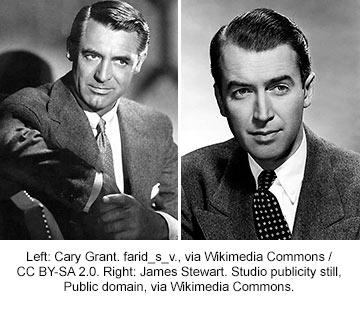
Which of the leading actors, Cary Grant or James Stewart, appeared in the most Alfred Hitchcock films?
A | Cary Grant |
B | James Stewart |
C | Tie |
Question 3 :
Answer C. Tie with four Hitchcock films each
Cary Grant
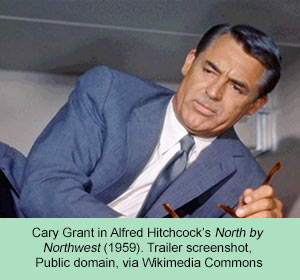
Suspicion (1941)
Notorious (1946)
To Catch a Thief (1955)
North by Northwest (1959)
Cary Grant was born Archibald Alexander Leach on January 18, 1904 in Horfield, Bristol, England, to Elsie Maria (Kingdon) and Elias James Leach, who worked in a factory. His early years in Bristol would have been an ordinary lower-middle-class childhood, except for one extraordinary event. At age nine, he came home from school one day and was told his mother had gone off to a seaside resort. However, the real truth was that she had been placed in a mental institution, where she would remain for years, and he was never told about it (he would not see his mother again until he was in his late 20s).
He left school at age 14, lying about his age and forging his father's signature on a letter to join Bob Pender's troupe of knockabout comedians. He learned pantomime as well as acrobatics as he toured with the Pender troupe in the English provinces, picked up a Cockney accent in the music halls in London, and then in July 1920, was one of the eight Pender boys selected to go to the United States. Their show on Broadway, "Good Times", ran for 456 performances, giving Grant time to acclimatize. He would stay in America. Mae West wanted Grant for She Done Him Wrong (1933) because she saw his combination of virility, sexuality and the aura and bearing of a gentleman. Grant was young enough to begin the new career of fatherhood when he stopped making movies at age 62.
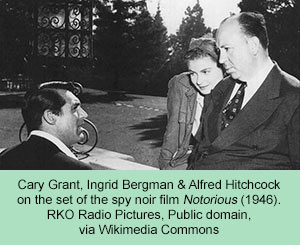
Earlier he had appeared in five films directed by Howard Hawks and three films each by Leo McCarey, George Cukor, George Stevens and Stanley Donen.
One biographer said the 6' 1½ Grant was alienated by the new realism in the film industry. In the 1950s and early 1960s, he had invented a man-of-the-world persona and a style - "high comedy with polished words." In To Catch a Thief (1955), he and Grace Kelly were allowed to improvise some of the dialogue. They knew what the director, Alfred Hitchcock, wanted to do with a scene, they rehearsed it, put in some clever double entendres that got past the censors, and then the scene was filmed. His biggest box-office success was another Hitchcock 1950s film, North by Northwest (1959) made with Eva Marie Saint since Kelly was by that time Princess of Monaco.
Although Grant retired from the screen, he remained active. He accepted a position on the board of directors at Faberge. By all accounts this position was not honorary, as some had assumed. Grant regularly attended meetings and traveled internationally to support them. The position also permitted use of a private plane, which Grant could use to fly to see his daughter wherever her mother Dyan Cannon, was working. He later joined the boards of Hollywood Park, the Academy of Magical Arts (The Magic Castle - Hollywood, California), Western Airlines (acquired by Delta Airlines in 1987) and MGM.
Grant expressed no interest in making a career comeback. He was in good health until almost the end of his life, when he suffered a mild stroke in October 1984. In his last years, he undertook tours of the United States in a one-man-show, "A Conversation with Cary Grant", in which he would show clips from his films and answer audience questions. On November 29, 1986, Cary Grant died at age 82 of a cerebral hemorrhage in Davenport, Iowa.
In 1999, the American Film Institute named Grant the second male star of Golden Age of Hollywood cinema (after Humphrey Bogart). Grant was known for comedic and dramatic roles; his best-known films include Bringing Up Baby (1938), The Philadelphia Story (1940), His Girl Friday (1940), Arsenic and Old Lace (1944), Notorious (1946), An Affair to Remember (1957), North by Northwest (1959) and Charade (1963).
Spouse (5)
Barbara Harris (11 April 1981 - 29 November 1986) (his death)
Dyan Cannon (22 July 1965 - 21 March 1968) (divorced) (1 child)
Betsy Drake (25 December 1949 - 13 August 1962) (divorced)
Barbara Hutton (8 July 1942 - 30 August 1945) (divorced)
Virginia Cherrill (9 February 1934 - 26 March 1935) (divorced)
Mini Biography By: Dale O'Connor
James Stewart
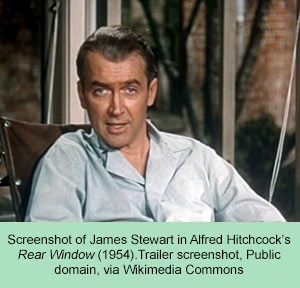
Rope (1948)
Rear Window (1954)
The Man Who Knew Too Much (1956)
Vertigo (1958)
James Maitland Stewart was born on May 20, 1908 in Indiana, Pennsylvania, to Elizabeth Ruth (Johnson) and Alexander Maitland Stewart, who owned a hardware store. He was of Scottish, Ulster-Scots, and some English, descent. Stewart was educated at a local prep school, Mercersburg Academy, where he was a keen athlete (football and track), musician (singing and accordion playing), and sometime actor.
In 1929, he won a place at Princeton University, where he studied architecture with some success and became further involved with the performing arts as a musician and actor with the University Players. After graduation, engagements with the University Players took him around the northeastern United States, including a run on Broadway in 1932. But work dried up as the Great Depression deepened, and it was not until 1934, when he followed his friend Henry Fonda to Hollywood, that things began to pick up.
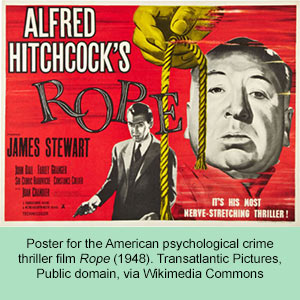
After his first screen appearance in Art Trouble (1934), the lanky 6' 3" Stewart worked for a time for MGM as a contract player and slowly began making a name for himself in increasingly high-profile roles throughout the rest of the 1930s. His famous collaborations with Frank Capra, in You Can't Take It with You (1938), Mr. Smith Goes to Washington (1939), and, after World War II, It's a Wonderful Life (1946) helped to launch his career as a star and to establish his screen persona as the likable "every man."
Having learned to fly in 1935, he was drafted into the United States Army in 1940 as a private (after twice failing the medical for being underweight). During the course of World War II he rose to the rank of colonel, first as an instructor at home in the United States, and later on combat missions in Europe. He remained involved with the United States Air Force Reserve after the war and retired in 1959 as a brigadier general.
Stewart's acting career took off properly after the war. During the course of his long professional life, he had roles in some of Hollywood's best-remembered films; starring in a string of Westerns by John Ford and eight Anthony Mann films.
On June 25, 1997, a thrombosis formed in his right leg, leading to a pulmonary embolism, and a week later on July 2, 1997, surrounded by his children, James Stewart died at age 89 at his home in Beverly Hills, California. His last words to his family were, "I'm going to be with Gloria now".
Spouse (1)
Gloria Stewart (1949 - 1994) (her death) (2 children)
Mini Biography by fmetz
Cary Grant

Suspicion (1941)
Notorious (1946)
To Catch a Thief (1955)
North by Northwest (1959)
Cary Grant was born Archibald Alexander Leach on January 18, 1904 in Horfield, Bristol, England, to Elsie Maria (Kingdon) and Elias James Leach, who worked in a factory. His early years in Bristol would have been an ordinary lower-middle-class childhood, except for one extraordinary event. At age nine, he came home from school one day and was told his mother had gone off to a seaside resort. However, the real truth was that she had been placed in a mental institution, where she would remain for years, and he was never told about it (he would not see his mother again until he was in his late 20s).
He left school at age 14, lying about his age and forging his father's signature on a letter to join Bob Pender's troupe of knockabout comedians. He learned pantomime as well as acrobatics as he toured with the Pender troupe in the English provinces, picked up a Cockney accent in the music halls in London, and then in July 1920, was one of the eight Pender boys selected to go to the United States. Their show on Broadway, "Good Times", ran for 456 performances, giving Grant time to acclimatize. He would stay in America. Mae West wanted Grant for She Done Him Wrong (1933) because she saw his combination of virility, sexuality and the aura and bearing of a gentleman. Grant was young enough to begin the new career of fatherhood when he stopped making movies at age 62.

Earlier he had appeared in five films directed by Howard Hawks and three films each by Leo McCarey, George Cukor, George Stevens and Stanley Donen.
One biographer said the 6' 1½ Grant was alienated by the new realism in the film industry. In the 1950s and early 1960s, he had invented a man-of-the-world persona and a style - "high comedy with polished words." In To Catch a Thief (1955), he and Grace Kelly were allowed to improvise some of the dialogue. They knew what the director, Alfred Hitchcock, wanted to do with a scene, they rehearsed it, put in some clever double entendres that got past the censors, and then the scene was filmed. His biggest box-office success was another Hitchcock 1950s film, North by Northwest (1959) made with Eva Marie Saint since Kelly was by that time Princess of Monaco.
Although Grant retired from the screen, he remained active. He accepted a position on the board of directors at Faberge. By all accounts this position was not honorary, as some had assumed. Grant regularly attended meetings and traveled internationally to support them. The position also permitted use of a private plane, which Grant could use to fly to see his daughter wherever her mother Dyan Cannon, was working. He later joined the boards of Hollywood Park, the Academy of Magical Arts (The Magic Castle - Hollywood, California), Western Airlines (acquired by Delta Airlines in 1987) and MGM.
Grant expressed no interest in making a career comeback. He was in good health until almost the end of his life, when he suffered a mild stroke in October 1984. In his last years, he undertook tours of the United States in a one-man-show, "A Conversation with Cary Grant", in which he would show clips from his films and answer audience questions. On November 29, 1986, Cary Grant died at age 82 of a cerebral hemorrhage in Davenport, Iowa.
In 1999, the American Film Institute named Grant the second male star of Golden Age of Hollywood cinema (after Humphrey Bogart). Grant was known for comedic and dramatic roles; his best-known films include Bringing Up Baby (1938), The Philadelphia Story (1940), His Girl Friday (1940), Arsenic and Old Lace (1944), Notorious (1946), An Affair to Remember (1957), North by Northwest (1959) and Charade (1963).
Spouse (5)
Barbara Harris (11 April 1981 - 29 November 1986) (his death)
Dyan Cannon (22 July 1965 - 21 March 1968) (divorced) (1 child)
Betsy Drake (25 December 1949 - 13 August 1962) (divorced)
Barbara Hutton (8 July 1942 - 30 August 1945) (divorced)
Virginia Cherrill (9 February 1934 - 26 March 1935) (divorced)
Mini Biography By: Dale O'Connor
James Stewart

Rope (1948)
Rear Window (1954)
The Man Who Knew Too Much (1956)
Vertigo (1958)
James Maitland Stewart was born on May 20, 1908 in Indiana, Pennsylvania, to Elizabeth Ruth (Johnson) and Alexander Maitland Stewart, who owned a hardware store. He was of Scottish, Ulster-Scots, and some English, descent. Stewart was educated at a local prep school, Mercersburg Academy, where he was a keen athlete (football and track), musician (singing and accordion playing), and sometime actor.
In 1929, he won a place at Princeton University, where he studied architecture with some success and became further involved with the performing arts as a musician and actor with the University Players. After graduation, engagements with the University Players took him around the northeastern United States, including a run on Broadway in 1932. But work dried up as the Great Depression deepened, and it was not until 1934, when he followed his friend Henry Fonda to Hollywood, that things began to pick up.

After his first screen appearance in Art Trouble (1934), the lanky 6' 3" Stewart worked for a time for MGM as a contract player and slowly began making a name for himself in increasingly high-profile roles throughout the rest of the 1930s. His famous collaborations with Frank Capra, in You Can't Take It with You (1938), Mr. Smith Goes to Washington (1939), and, after World War II, It's a Wonderful Life (1946) helped to launch his career as a star and to establish his screen persona as the likable "every man."
Having learned to fly in 1935, he was drafted into the United States Army in 1940 as a private (after twice failing the medical for being underweight). During the course of World War II he rose to the rank of colonel, first as an instructor at home in the United States, and later on combat missions in Europe. He remained involved with the United States Air Force Reserve after the war and retired in 1959 as a brigadier general.
Stewart's acting career took off properly after the war. During the course of his long professional life, he had roles in some of Hollywood's best-remembered films; starring in a string of Westerns by John Ford and eight Anthony Mann films.
On June 25, 1997, a thrombosis formed in his right leg, leading to a pulmonary embolism, and a week later on July 2, 1997, surrounded by his children, James Stewart died at age 89 at his home in Beverly Hills, California. His last words to his family were, "I'm going to be with Gloria now".
Spouse (1)
Gloria Stewart (1949 - 1994) (her death) (2 children)
Mini Biography by fmetz
Question 4 |
Name the scrappy Hollywood actress that appeared in High Sierra and The Big Knife, who became one of Hollywood’s first female directors with The Bigamist, The Hitch-Hiker, On Dangerous Ground (uncredited as director but costars), Hard, Fast and Beautiful and Outrage?
A | Joan Blondel |
B | Lillian Gish |
C | Gloria Grahame |
D | Ida Lupino |
E | Anne Sheridan |
Question 4 :
Answer: D. Ida Lupino
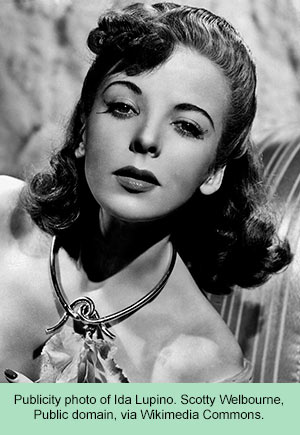
Ida Lupino was born in London to a show business family. In 1932, her mother brought Ida with her to an audition and Ida got the part her mother wanted. The picture was Her First Affaire (1932). Ida, a bleached blonde, came to Hollywood in 1934 and played small and insignificant parts. Peter Ibbetson (1935) was one of her few noteworthy movies and it was not until The Light That Failed (1939) that she got a chance to get better parts. In most of her movies, she was cast as the hard, but sympathetic woman from the wrong side of the tracks. In The Sea Wolf (1941) and High Sierra (1941), she played the part magnificently.
It has been said that no one could do hard-luck dames the way Lupino could do them. She played tough, knowing characters who held their own against some of the biggest leading men of the day — Humphrey Bogart, Ronald Colman, John Garfield and Edward G. Robinson. She made a handful of films during the forties playing different characters ranging from Pillow to Post (1945), where she played a traveling saleswoman to the tough nightclub singer in The Man I Love (1946). But good roles for women were hard to get and there were many young actresses and established stars competing for those roles.
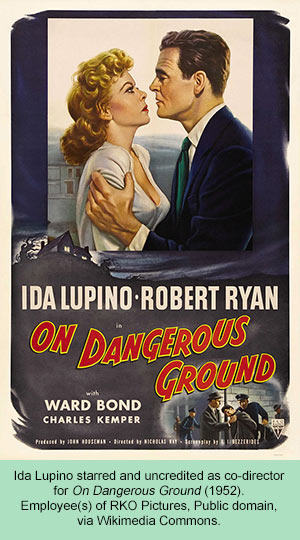
She left Warner Brothers in 1947 and became a freelance actress. When better roles did not materialize, Ida stepped behind the camera as a director, writer and producer. Her first directing job came when director Elmer Clifton fell ill on a script that she co-wrote Not Wanted (1949). Ida had joked that as an actress, she was the poor man's Bette Davis. Now, she said that as a director, she became the poor man's Don Siegel. The films that she wrote, or directed, or appeared in during the fifties were mostly inexpensive melodramas. She later turned to Television where she directed episodes in shows such as The Untouchables (1959) and The Fugitive (1963). In the seventies, she did guest appearances on various television show and small parts in a few movies.
IMDb Mini Biography By: Tony Fontana

Ida Lupino was born in London to a show business family. In 1932, her mother brought Ida with her to an audition and Ida got the part her mother wanted. The picture was Her First Affaire (1932). Ida, a bleached blonde, came to Hollywood in 1934 and played small and insignificant parts. Peter Ibbetson (1935) was one of her few noteworthy movies and it was not until The Light That Failed (1939) that she got a chance to get better parts. In most of her movies, she was cast as the hard, but sympathetic woman from the wrong side of the tracks. In The Sea Wolf (1941) and High Sierra (1941), she played the part magnificently.
It has been said that no one could do hard-luck dames the way Lupino could do them. She played tough, knowing characters who held their own against some of the biggest leading men of the day — Humphrey Bogart, Ronald Colman, John Garfield and Edward G. Robinson. She made a handful of films during the forties playing different characters ranging from Pillow to Post (1945), where she played a traveling saleswoman to the tough nightclub singer in The Man I Love (1946). But good roles for women were hard to get and there were many young actresses and established stars competing for those roles.

She left Warner Brothers in 1947 and became a freelance actress. When better roles did not materialize, Ida stepped behind the camera as a director, writer and producer. Her first directing job came when director Elmer Clifton fell ill on a script that she co-wrote Not Wanted (1949). Ida had joked that as an actress, she was the poor man's Bette Davis. Now, she said that as a director, she became the poor man's Don Siegel. The films that she wrote, or directed, or appeared in during the fifties were mostly inexpensive melodramas. She later turned to Television where she directed episodes in shows such as The Untouchables (1959) and The Fugitive (1963). In the seventies, she did guest appearances on various television show and small parts in a few movies.
IMDb Mini Biography By: Tony Fontana
Question 5 |
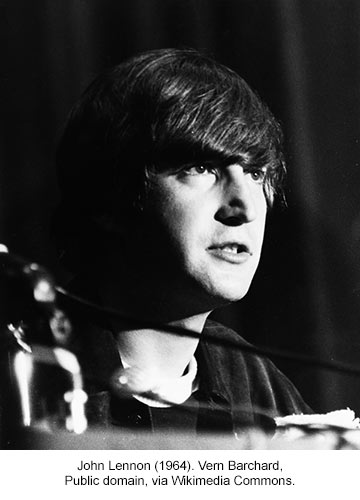
John Lennon and the Beatles appeared in two Richard Lester musicals, but name a third Lester film where Lennon played a dramatic role.
A | Ferry Across the Mersey |
B | How I Won the War |
C | Performance |
D | Petulia |
E | The Running, Jumping and Standing Still Film |
Question 5 :
Answer: B. How I Won the War (1967)
Director: Richard Lester
Writers: Patrick Ryan (novel), Charles Wood (screenplay)
Stars: Michael Crawford, John Lennon, Roy Kinnear
How I Won the War is a 1967 British black comedy film directed and produced by Richard Lester, based on a novel of the same name by Patrick Ryan. The film stars Michael Crawford as bungling British Army Officer Lieutenant Earnest Goodbody, with John Lennon of The Beatles (in his only non-musical role, as Musketeer Gripweed), Jack MacGowran (Musketeer Juniper), Roy Kinnear (Musketeer Clapper) and Lee Montague (Sergeant, although referred to by the equivalent, albeit fictional rank of "Corporal of Musket" Transom) as soldiers under his command.
The film uses an inconsistent variety of styles — vignette, straight-to-camera, and, extensively, parody of the war film genre, docu-drama, and popular war literature — to tell the story of 3rd Troop, the 4th Musketeers (a fictional regiment reminiscent of the Royal Fusiliers and the Household Cavalry) and their misadventures in the Second World War. This is told in the comic/absurdist vein throughout, a central plot being the setting-up of an "Advanced Area Cricket Pitch" behind enemy lines in North Africa, but it is all broadly based on the Western Desert Campaign in mid-late 1942 and the crossing of the last intact bridge on the Rhine at Remagen in early 1945. The film was not critically well received.
Plot
Lieutenant Goodbody is an inept, idealistic, naïve, and almost relentlessly jingoistic wartime-commissioned (not regular) officer. One of the main subversive themes in the film is the platoon's repeated attempts or temptations to kill or otherwise rid themselves of their complete liability of a commander. While Goodbody's ineptitude and attempts at derring-do lead to the gradual demise of the unit, he survives, together with the unit's persistent deserter and another of his charges who become confined to psychiatric care. Every time a character is killed, he is replaced by an actor in bright red, blue, or green-colored World War II uniform, whose face is also colored and obscured so that he appears to be a living toy soldier. This reinforces Goodbody's repeated comparisons of war to playing a game.
John Lennon
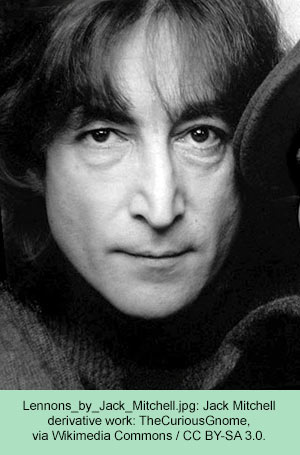
John Winston (later Ono) Lennon was born on October 9, 1940, in Liverpool, England, to Julia Lennon (née Stanley) and Alfred Lennon, a merchant seaman. He was raised by his mother's older sister Mimi Smith. In the mid-1950s, he formed his first band, The Quarrymen (after Quarry Bank High School, which he attended) who, with the addition of Paul McCartney and George Harrison, later became The Beatles.
After some years of performing in Liverpool and Hamburg, Germany, "Beatlemania" erupted in England and Europe in 1963 after the release of their singles "Love Me Do" and "Please Please Me". That same year, John's first wife Cynthia Lennon welcomed their only son Julian Lennon, named after John's mother. The next year the Beatles flew to America to appear on The Ed Sullivan Show (1948) (aka The Ed Sullivan Show), and Beatlemania spread worldwide. Queen Elizabeth II granted all four Beatles M.B.E. medals in 1965, for import revenues from their record sales; John returned his four years later, as part of an antiwar statement. John and the Beatles continued to tour and perform live until 1966, when protests over his calling the Beatles phenomenon "more popular than Jesus" and the frustrations of touring made the band decide to quit the road. They devoted themselves to studio work, recording and releasing albums such as "Sgt. Pepper's Lonely Hearts Club Band," "Magical Mystery Tour" and the "White Album." Instead of appearing live, the band began making their own "pop clips" (an early term for music videos), which were featured on television programs of the time.
In the late 1960s John began performing and making albums with his second wife Yoko Ono, as the Beatles began to break up. Their first two albums, "Two Virgins" and "Life With The Lions," were experimental and flops by Beatles standards, while their "Wedding Album" was almost a vanity work, but their live album "Live Peace In Toronto" became a Top Ten hit, at the end of the 1960s.
In the early 1970s John and Yoko continued to record together, making television appearances and performing at charity concerts. After the release of John's biggest hit, "Imagine", they moved to the US, where John was nearly deported because of his political views (a late '60s conviction for possession of hashish in the U.K. was the excuse given by the government), but after a four-year legal battle he won the right to stay. In the midst of this, John and Yoko separated for over a year; John lived in Los Angeles with personal assistant May Pang, while Yoko dated guitarist David Spinozza. When John made a guest appearance at Elton John's Thanksgiving 1974 concert, Yoko was in the audience, and surprised John backstage. They reconciled in early 1975, and Yoko soon became pregnant. After the birth of their son Sean Lennon, John settled into the roles of "househusband" and full-time daddy, while Yoko became his business manager; both appeared happy in their new life together.
After a five-year break from music and the public eye, they made a comeback with their album "Double Fantasy," but within weeks of their re-emergence, Lennon was murdered on the evening of December 8, 1980 by Mark David Chapman, a one-time Beatles fan angry and jealous over John's ongoing career, who fatally shot Lennon four times in the back outside his apartment building, The Dakota, as Lennon was returning from a recording session. Within minutes after being shot, John Lennon was dead at age 40. His violent death was a sudden and tragic end to the life of a talented singer and musician who wanted to make a difference in the world.
IMDb Mini Biography By: paulab
Richard Lester
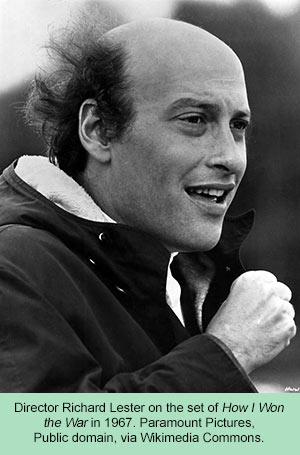
Richard Lester was one of the most influential directors of the 1960s, and continued his career into the 1970s and early '80s. He is best remembered for the two films he helmed starring The Beatles: A Hard Day's Night (1964) and Help! (1965), the frenetic cutting style of which was seen by many as the predecessor of the music video a generation later.
Lester had made his name with the Oscar-nominated short subject The Running Jumping & Standing Still Film (1959) that he made with "The Goon Show" veterans Peter Sellers and Spike Milligan. He then directed Sellers in The Mouse on the Moon (1963), which was produced by Walter Shenson. The Goons were a favorite of The Beatles, and when Shenson got the rights to make a movie with The Beatles, Lester seemed to be the ideal director for the project.
That project, "A Hard Day's Night," was not only a huge box-office hit but a major critical success as well. "Village Voice" movie critic Andrew Sarris, the American promoter of the "auteur theory" in America, described "A Hard Day's Night" as "the Citizen Kane (1941) of juke box musicals." Lester had arrived, and his next film, the Swinging Sixties yarn The Knack... and How to Get It (1965), won the Palme d'Or at the 1966 Cannes Film Festival. He also directed the wildly satirical How I Won the War (1967), which came a year after the huge success of A Funny Thing Happened on the Way to the Forum (1966), his adaptation of the smash Broadway play, which relied on the Keatonesque slapstick Lester had used so well in The Beatles films ("Forum" even featured Lester's hero Buster Keaton in a small but highly amusing role).
Aside from "A Hard Day's Night," the success of which relies as much on The Beatles themselves as auteurs (Lester claims that the script by Alun Owen was largely jettisoned during filming, and its scripted "quips" were replaced by the real things from The Beatles themselves), Lester's true '60s masterpiece is Petulia (1968). A corrosive look at the American upper-middle-class and the fragmentation of American society, "Petulia" is one of the great, if unheralded, American films. Propelled by the luminous presence of Julie Christie and the powerhouse performance of George C. Scott, "Petulia" was a success at the box office, although some critics were upset over the blackness of the comedy. It was to prove to be his last great film, as he stumbled soon after it was released. The Bed Sitting Room (1969), a Samuel Beckett-influenced satire based on a play (and script) by Spike Milligan co-starring Dudley Moore and Peter Cooke -- from the smash revue "Beyond the Fringe" -- was a resounding flop at the box office and among critics, and Lester found himself unemployable.
However, The Three Musketeers (1973), which he shot simultaneously with The Four Musketeers: Milady's Revenge (1974) for producer Ilya Salkind, resurrected his career. When the Salkinds (Ilya and his father Alexander Salkind) were in the midst of filming Superman (1978) simultaneously with its sequel, Lester was hired as a supervising producer, then took over the filming of the sequel, Superman II (1980), when original director Richard Donner was fired. The sequel was a financial and critical success (as much as comic book films were in the early 1980s), and he was hired to direct the far-less successful Superman III (1983).
At the end of the 1980s, Lester returned to the storyline that had revitalized his career back in the early 1970s, filming a second sequel to "The Three Musketeers." However, after his close friend, actor Roy Kinnear died during the shooting of The Return of the Musketeers (1989), Lester seemed to lose heart with the movie-making business. He has not directed another film.
Mini Biography By: Jon C. Hopwood
Director: Richard Lester
Writers: Patrick Ryan (novel), Charles Wood (screenplay)
Stars: Michael Crawford, John Lennon, Roy Kinnear
How I Won the War is a 1967 British black comedy film directed and produced by Richard Lester, based on a novel of the same name by Patrick Ryan. The film stars Michael Crawford as bungling British Army Officer Lieutenant Earnest Goodbody, with John Lennon of The Beatles (in his only non-musical role, as Musketeer Gripweed), Jack MacGowran (Musketeer Juniper), Roy Kinnear (Musketeer Clapper) and Lee Montague (Sergeant, although referred to by the equivalent, albeit fictional rank of "Corporal of Musket" Transom) as soldiers under his command.
The film uses an inconsistent variety of styles — vignette, straight-to-camera, and, extensively, parody of the war film genre, docu-drama, and popular war literature — to tell the story of 3rd Troop, the 4th Musketeers (a fictional regiment reminiscent of the Royal Fusiliers and the Household Cavalry) and their misadventures in the Second World War. This is told in the comic/absurdist vein throughout, a central plot being the setting-up of an "Advanced Area Cricket Pitch" behind enemy lines in North Africa, but it is all broadly based on the Western Desert Campaign in mid-late 1942 and the crossing of the last intact bridge on the Rhine at Remagen in early 1945. The film was not critically well received.
Plot
Lieutenant Goodbody is an inept, idealistic, naïve, and almost relentlessly jingoistic wartime-commissioned (not regular) officer. One of the main subversive themes in the film is the platoon's repeated attempts or temptations to kill or otherwise rid themselves of their complete liability of a commander. While Goodbody's ineptitude and attempts at derring-do lead to the gradual demise of the unit, he survives, together with the unit's persistent deserter and another of his charges who become confined to psychiatric care. Every time a character is killed, he is replaced by an actor in bright red, blue, or green-colored World War II uniform, whose face is also colored and obscured so that he appears to be a living toy soldier. This reinforces Goodbody's repeated comparisons of war to playing a game.
John Lennon

John Winston (later Ono) Lennon was born on October 9, 1940, in Liverpool, England, to Julia Lennon (née Stanley) and Alfred Lennon, a merchant seaman. He was raised by his mother's older sister Mimi Smith. In the mid-1950s, he formed his first band, The Quarrymen (after Quarry Bank High School, which he attended) who, with the addition of Paul McCartney and George Harrison, later became The Beatles.
After some years of performing in Liverpool and Hamburg, Germany, "Beatlemania" erupted in England and Europe in 1963 after the release of their singles "Love Me Do" and "Please Please Me". That same year, John's first wife Cynthia Lennon welcomed their only son Julian Lennon, named after John's mother. The next year the Beatles flew to America to appear on The Ed Sullivan Show (1948) (aka The Ed Sullivan Show), and Beatlemania spread worldwide. Queen Elizabeth II granted all four Beatles M.B.E. medals in 1965, for import revenues from their record sales; John returned his four years later, as part of an antiwar statement. John and the Beatles continued to tour and perform live until 1966, when protests over his calling the Beatles phenomenon "more popular than Jesus" and the frustrations of touring made the band decide to quit the road. They devoted themselves to studio work, recording and releasing albums such as "Sgt. Pepper's Lonely Hearts Club Band," "Magical Mystery Tour" and the "White Album." Instead of appearing live, the band began making their own "pop clips" (an early term for music videos), which were featured on television programs of the time.
In the late 1960s John began performing and making albums with his second wife Yoko Ono, as the Beatles began to break up. Their first two albums, "Two Virgins" and "Life With The Lions," were experimental and flops by Beatles standards, while their "Wedding Album" was almost a vanity work, but their live album "Live Peace In Toronto" became a Top Ten hit, at the end of the 1960s.
In the early 1970s John and Yoko continued to record together, making television appearances and performing at charity concerts. After the release of John's biggest hit, "Imagine", they moved to the US, where John was nearly deported because of his political views (a late '60s conviction for possession of hashish in the U.K. was the excuse given by the government), but after a four-year legal battle he won the right to stay. In the midst of this, John and Yoko separated for over a year; John lived in Los Angeles with personal assistant May Pang, while Yoko dated guitarist David Spinozza. When John made a guest appearance at Elton John's Thanksgiving 1974 concert, Yoko was in the audience, and surprised John backstage. They reconciled in early 1975, and Yoko soon became pregnant. After the birth of their son Sean Lennon, John settled into the roles of "househusband" and full-time daddy, while Yoko became his business manager; both appeared happy in their new life together.
After a five-year break from music and the public eye, they made a comeback with their album "Double Fantasy," but within weeks of their re-emergence, Lennon was murdered on the evening of December 8, 1980 by Mark David Chapman, a one-time Beatles fan angry and jealous over John's ongoing career, who fatally shot Lennon four times in the back outside his apartment building, The Dakota, as Lennon was returning from a recording session. Within minutes after being shot, John Lennon was dead at age 40. His violent death was a sudden and tragic end to the life of a talented singer and musician who wanted to make a difference in the world.
IMDb Mini Biography By: paulab
Richard Lester

Richard Lester was one of the most influential directors of the 1960s, and continued his career into the 1970s and early '80s. He is best remembered for the two films he helmed starring The Beatles: A Hard Day's Night (1964) and Help! (1965), the frenetic cutting style of which was seen by many as the predecessor of the music video a generation later.
Lester had made his name with the Oscar-nominated short subject The Running Jumping & Standing Still Film (1959) that he made with "The Goon Show" veterans Peter Sellers and Spike Milligan. He then directed Sellers in The Mouse on the Moon (1963), which was produced by Walter Shenson. The Goons were a favorite of The Beatles, and when Shenson got the rights to make a movie with The Beatles, Lester seemed to be the ideal director for the project.
That project, "A Hard Day's Night," was not only a huge box-office hit but a major critical success as well. "Village Voice" movie critic Andrew Sarris, the American promoter of the "auteur theory" in America, described "A Hard Day's Night" as "the Citizen Kane (1941) of juke box musicals." Lester had arrived, and his next film, the Swinging Sixties yarn The Knack... and How to Get It (1965), won the Palme d'Or at the 1966 Cannes Film Festival. He also directed the wildly satirical How I Won the War (1967), which came a year after the huge success of A Funny Thing Happened on the Way to the Forum (1966), his adaptation of the smash Broadway play, which relied on the Keatonesque slapstick Lester had used so well in The Beatles films ("Forum" even featured Lester's hero Buster Keaton in a small but highly amusing role).
Aside from "A Hard Day's Night," the success of which relies as much on The Beatles themselves as auteurs (Lester claims that the script by Alun Owen was largely jettisoned during filming, and its scripted "quips" were replaced by the real things from The Beatles themselves), Lester's true '60s masterpiece is Petulia (1968). A corrosive look at the American upper-middle-class and the fragmentation of American society, "Petulia" is one of the great, if unheralded, American films. Propelled by the luminous presence of Julie Christie and the powerhouse performance of George C. Scott, "Petulia" was a success at the box office, although some critics were upset over the blackness of the comedy. It was to prove to be his last great film, as he stumbled soon after it was released. The Bed Sitting Room (1969), a Samuel Beckett-influenced satire based on a play (and script) by Spike Milligan co-starring Dudley Moore and Peter Cooke -- from the smash revue "Beyond the Fringe" -- was a resounding flop at the box office and among critics, and Lester found himself unemployable.
However, The Three Musketeers (1973), which he shot simultaneously with The Four Musketeers: Milady's Revenge (1974) for producer Ilya Salkind, resurrected his career. When the Salkinds (Ilya and his father Alexander Salkind) were in the midst of filming Superman (1978) simultaneously with its sequel, Lester was hired as a supervising producer, then took over the filming of the sequel, Superman II (1980), when original director Richard Donner was fired. The sequel was a financial and critical success (as much as comic book films were in the early 1980s), and he was hired to direct the far-less successful Superman III (1983).
At the end of the 1980s, Lester returned to the storyline that had revitalized his career back in the early 1970s, filming a second sequel to "The Three Musketeers." However, after his close friend, actor Roy Kinnear died during the shooting of The Return of the Musketeers (1989), Lester seemed to lose heart with the movie-making business. He has not directed another film.
Mini Biography By: Jon C. Hopwood
Once you are finished, click the button below. Any items you have not completed will be marked incorrect.
Get Results
There are 5 questions to complete.
You have completed
questions
question
Your score is
Correct
Wrong
Partial-Credit
You have not finished your quiz. If you leave this page, your progress will be lost.
Correct Answer
You Selected
Not Attempted
Final Score on Quiz
Attempted Questions Correct
Attempted Questions Wrong
Questions Not Attempted
Total Questions on Quiz
Question Details
Results
Date
Score
Hint
Time allowed
minutes
seconds
Time used
Answer Choice(s) Selected
Question Text
All done
Deplorable! You need to travel more! This is pathetic!
Deplorable! You need to travel more! This is pathetic!
Embarrassing! Keep trying! We know you're better than that. Play the game again.
Not that bad! But not good either. Play the game again.
Pretty good... but not perfect.
Perfect! Are you brilliant traveler or what?
